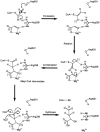Structure of the Escherichia coli malate synthase G:pyruvate:acetyl-coenzyme A abortive ternary complex at 1.95 A resolution
- PMID: 12930982
- PMCID: PMC2323980
- DOI: 10.1110/ps.03174303
Structure of the Escherichia coli malate synthase G:pyruvate:acetyl-coenzyme A abortive ternary complex at 1.95 A resolution
Abstract
Malate synthase, an enzyme of the glyoxylate pathway, catalyzes the condensation and subsequent hydrolysis of acetyl-coenzyme A (acetyl-CoA) and glyoxylate to form malate and CoA. In the present study, we present the 1.95 A-resolution crystal structure of Escherichia coli malate synthase isoform G in complex with magnesium, pyruvate, and acetyl-CoA, and we compare it with previously determined structures of substrate and product complexes. The results reveal how the enzyme recognizes and activates the substrate acetyl-CoA, as well as conformational changes associated with substrate binding, which may be important for catalysis. On the basis of these results and mutagenesis of active site residues, Asp 631 and Arg 338 are proposed to act in concert to form the enolate anion of acetyl-CoA in the rate-limiting step. The highly conserved Cys 617, which is immediately adjacent to the presumed catalytic base Asp 631, appears to be oxidized to cysteine-sulfenic acid. This can explain earlier observations of the susceptibility of the enzyme to inactivation and aggregation upon X-ray irradiation and indicates that cysteine oxidation may play a role in redox regulation of malate synthase activity in vivo. There is mounting evidence that enzymes of the glyoxylate pathway are virulence factors in several pathogenic organisms, notably Mycobacterium tuberculosis and Candida albicans. The results described in this study add insight into the mechanism of catalysis and may be useful for the design of inhibitory compounds as possible antimicrobial agents.
Figures






Similar articles
-
Crystal structure of Escherichia coli malate synthase G complexed with magnesium and glyoxylate at 2.0 A resolution: mechanistic implications.Biochemistry. 2000 Mar 21;39(11):3156-68. doi: 10.1021/bi992519h. Biochemistry. 2000. PMID: 10715138
-
Atomic resolution structures of Escherichia coli and Bacillus anthracis malate synthase A: comparison with isoform G and implications for structure-based drug discovery.Protein Sci. 2008 Nov;17(11):1935-45. doi: 10.1110/ps.036269.108. Epub 2008 Aug 19. Protein Sci. 2008. PMID: 18714089 Free PMC article.
-
Ligand binding on to maize (Zea mays) malate synthase: a structural study.Biochem J. 1994 Oct 15;303 ( Pt 2)(Pt 2):413-21. doi: 10.1042/bj3030413. Biochem J. 1994. PMID: 7980399 Free PMC article.
-
Crystal structures of a halophilic archaeal malate synthase from Haloferax volcanii and comparisons with isoforms A and G.BMC Struct Biol. 2011 May 10;11:23. doi: 10.1186/1472-6807-11-23. BMC Struct Biol. 2011. PMID: 21569248 Free PMC article.
-
How an overlooked gene in coenzyme a synthesis solved an enzyme mechanism predicament.Mol Microbiol. 2023 Jun;119(6):687-694. doi: 10.1111/mmi.15070. Epub 2023 May 4. Mol Microbiol. 2023. PMID: 37140060 Free PMC article. Review.
Cited by
-
A single-residue mutation, G203E, causes 3-hydroxy-3-methylglutaric aciduria by occluding the substrate channel in the 3D structural model of HMG-CoA lyase.J Inherit Metab Dis. 2006 Feb;29(1):64-70. doi: 10.1007/s10545-006-0138-x. J Inherit Metab Dis. 2006. PMID: 16601870
-
Monitoring global protein thiol-oxidation and protein S-mycothiolation in Mycobacterium smegmatis under hypochlorite stress.Sci Rep. 2017 Apr 26;7(1):1195. doi: 10.1038/s41598-017-01179-4. Sci Rep. 2017. PMID: 28446771 Free PMC article.
-
Solution NMR-derived global fold of a monomeric 82-kDa enzyme.Proc Natl Acad Sci U S A. 2005 Jan 18;102(3):622-7. doi: 10.1073/pnas.0407792102. Epub 2005 Jan 6. Proc Natl Acad Sci U S A. 2005. PMID: 15637152 Free PMC article.
-
3-Keto-5-aminohexanoate cleavage enzyme: a common fold for an uncommon Claisen-type condensation.J Biol Chem. 2011 Aug 5;286(31):27399-405. doi: 10.1074/jbc.M111.253260. Epub 2011 Jun 1. J Biol Chem. 2011. PMID: 21632536 Free PMC article.
-
Systematic replacement of lysine with glutamine and alanine in Escherichia coli malate synthase G: effect on crystallization.Acta Crystallogr Sect F Struct Biol Cryst Commun. 2005 Dec 1;61(Pt 12):1069-74. doi: 10.1107/S1744309105036559. Epub 2005 Nov 24. Acta Crystallogr Sect F Struct Biol Cryst Commun. 2005. PMID: 16511237 Free PMC article.
References
-
- Appel, R.D., Baroch, A., and Hochstrasser, D.F. 1994. A new generation of information retrieval tools for biologists: The example of the ExPASy WWW server. Trends. Biochem. Sci. 19 258–261. - PubMed
-
- Bove, J., Martin, R.O., Ingraham, L.L., and Stumpf, P.K. 1959. Studies of the mechanism of action of the condensing enzyme. J. Biol. Chem. 234 999–1003. - PubMed
-
- Brandon, C. and Tooze, J. 1999. Introduction to protein structure. Garland Publishing, New York.
-
- Carson, M. 1997. Ribbons. Methods Enzymol. 277 493–505. - PubMed
Publication types
MeSH terms
Substances
Grants and funding
LinkOut - more resources
Full Text Sources
Molecular Biology Databases

